With the growth in agricultural activity, industry, and population, water consumption has increased dramatically. In states with a huge population and a large agribusiness, such as California, and in high- growth desert states such as Arizona, the demand for water threatens to over whelm supply. In California it's estimated that 85 per cent of the state’s water is used for agricultural irrigation. In the San Joaquin Valley, a major agricultural area, pumping subterranean water for irrigation purposes began in 1925. Since that time, the floor of the valley has sunk 10 feet (3 meters) as the water has been pumped from beneath it.
In New York City an estimated 20 percent of all city water is wasted through leaks in antiquated water mains. Many predict that the next major resource crisis may be the shortage of water, not oil. Water rationing has already become commonplace in many cities; through stringent conservation measures the city of San Francisco has cut water consumption by 25 percent. In this section we will review ways to cut your family’s water consumption by 50 percent or more.
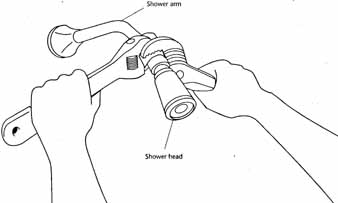
Shower Head Replacement: Install low-flow shower heads
to conserve bath water.
PER CAPITA WATER CONSUMPTION
On a per capita basis, the U.S. consumes 80 gallons (320 liters) of water per day, and it's estimated that 62 percent of that water, or 50 gallons (189 liters) of water per person, is wasted. For example, per capita outdoor water usage for lawn and garden accounts for 28 gal- ions (112 liters) of water daily; toilet use, 17 gallons (68 liters); bathing, 13 gallons (52 liters); and laundry, 11 gallons (44 liters). To reduce water consumption, we can change wasteful habits, repair leaking faucets and pipes, replace or repair plumbing fixtures, and control water usage for purposes such as watering the lawn or washing the car.
REDUCING WATER CONSUMPTION
Lingering in the shower, letting water run while brushing our teeth or washing our hair, using the toilet as a disposal to flush away paper waste, rinsing garden vegetables under running water, overwatering the lawn and garden, and hose washing the car all can consume a large amount of water. However, with little effort, we could eliminate much of the waste.
To reduce household water usage, install low-flow shower heads and limit time in the shower. Shut water off while you are brushing your teeth, and wash all items in a stoppered sink rather than under running water.
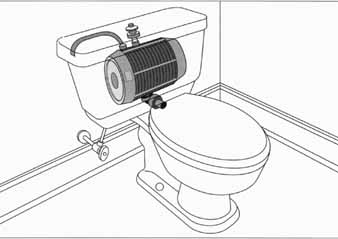
Toilet: New toilets use about one-third as much water
as older units. This unit uses air power to increase flush velocity.
Water generated by an air conditioner or a dehumidifier is mineral-free, and if it's poured down the drain, the clean water becomes so much sewage to be treated.
Rather than pouring it down the drain, collect and use the water for household purposes. Rather than buying distilled water, use the water in your steam iron, or to water the garden or houseplants. Minerals in water also can affect the color quality of latex paints: use the mineral-free water for thinning latex paints and for paint tool cleanup. Because mineral-free water will not corrode the radiator, mix it 50:50 with antifreeze and use it in the radiator of the car.
When washing the car at home, first use the hose to rinse the car with clean water and remove the grit and grime from the car finish. Then wash the car with a pail and sponge to remove dirt. Finally, use the hose to rinse the cat When possible, drive your car through an automated car wash, which is more efficient and uses less water, rather than washing it at home.
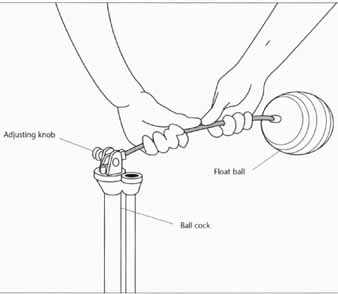
Float Ball: To reduce water usage on old-style float
balls, bend the float arm down.
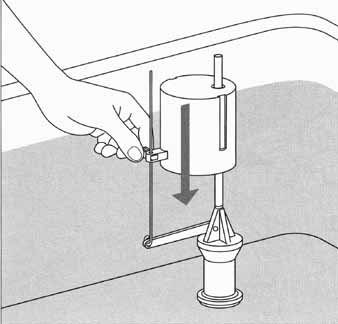
Float Cup: To reduce water usage on new flush valves,
pinch the clip and slide the cup down the rod.
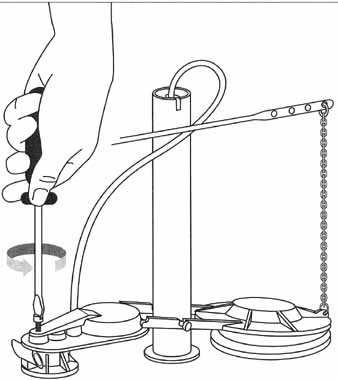
Metered Valve: Turn the screwdriver counterclockwise to lower the water level.
PLUMBING
Leaking Faucets
To conserve water, repair leaking pipes or faucets. A leak of one drop per second can waste 2,300 gallons (9,500 liters) of water per year. Multiply this figure by the number of leaking faucets in the house, and you may find that repairing the faucets will result in considerable water—and cost—savings.
Plumbing Fixtures
Old-style plumbing fixtures each waste hundreds of gallons (liters) of water per year. For example, older toilets may use up to 7 gallons (28 liters) of water per flush; low-flow toilets may operate on 1-½ gallons (6 liters) per flush. If you are not ready to replace the toilet fixture, you can bend the float ball arm down so the toilet tank shuts off before extra water is used to fill it. Or fill plastic bottles with water and place them in the toilet tank to displace a gallon or more of the water. This permits the toilet to flush, and does not affect toilet operation, but does reduce water consumption. At repair time, replace the old flush-ball type with a modern plastic flush valve. The plastic flush valves are adjustable so you can set them to shut off when the water level in the toilet tank reaches a pre-selected depth.
To calculate the water savings of low-flow toilets, consider that, when com pared to older units, the toilet saves about 4 gallons (16 liters) of water per flush. Let us assume that for a family of four the toilet will be flushed an average of 16 times per day, an estimate that may be conservative. Multiply 4 gallons (16 liters) of water saved per flush x 16 flushes = 64 gallons (256 liters of water saved per day x 365 days = 23,360 gallons (93,440 liters) of water saved per year per household by installing a low-flush toilet.
Shower heads
Old-style shower heads, with a water flow rate of 5 to 8 gallons (20 to 32 liters) per minute, waste thousands of gallons—or liters—of water daily. New low-flow shower heads use only 3 gallons (12 liters) of water or less per minute. This means that a low-flow shower head can save 10 gallons (40 liters) of water or more during each three-minute shower. For a family of four, that could be a savings of 40 gallons (160 liters) per day x 365 days 14,600 gallons (58,000 liters) of water saved per year.
Laundry
To conserve water, wash only full loads of clothes and select the wash cycle care fully. Using the permanent press cycle may require an extra rinse, which means you are using an extra water fill. That extra fill can use 5 gallons (20 liters) of water. To save energy, use cold- water detergents and run the washer on the cold temperature setting only.
Dishwashing
Hand washing dishes under running water can use 5 gallons (20 liters) of water per minute.
If you hand wash dishes, don't leave the water running. Put the stopper in the drain and fill the sink with hot water. Wash the dishes, then place them in the dish rack. When you are finished washing dishes, use the spray nozzle to rinse the dishes.
Compared to hand washing, using the dishwasher can save up to 10 gallons (40 liters) of water. For maximum savings, run only full loads when you wash dishes.
LAWN AND GARDEN
Outside water usage is the largest single category of all home water consumption, using up to 28 gallons (112 liters) of water per day per person. Most of this water goes on the lawn and gar den. By adopting good conservation methods, you can greatly reduce the amount of water used for these purposes and , at the same time, have a healthier lawn.
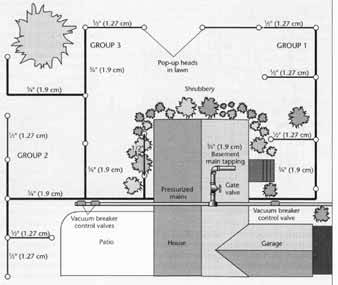
Lawn Sprinkler Systems: Automatic lawn sprinkler system
permits you to control and conserve on water usage. Two inches (5 centimeters)
of water per two-week period (including rain) keeps lawn healthy without
wasting water.
Test the Soil’s pH Balance
Soil that has a proper pH balance will grow a healthy lawn and require less water and chemicals. The term “pH” refers to potential hydrogen. The right pH balance for your lawn will vary by climate and type of turf. Check with your local garden center or college agricultural offices to learn the right pH for your lawn.
For most lawns experts advise having a neutral pH of between 5 and 7. This means that the soil is neither acid nor alkaline. Experts recommend adding lime to neutralize acid soil, and adding sulphur to balance alkaline soil.
If soil is compacted, aerate the lawn. The aerator machine will punch hundreds of small holes in the lawn so that moisture and nutrients reach the roots more easily.
One clue that the lawn is getting too little water is thatch buildup, which is caused by grass roots growing to the surface to seek water. Night crawlers (large worms that are active at night) are evidence of thatch buildup. Do not use chemicals to rid the lawn of night crawlers; rent a de-thatcher, a sort of power rake, instead.
When you water the lawn, apply at least the equivalent of 1 inch (2.5 centimeters) of rain with each watering, which is enough water to penetrate to root level. Water requirements vary by grass species and by your climate. As a general rule, experts advise that bluegrass lawns require a total of 2 inches (5 centimeters) of water every two weeks. That total includes both rainfall and watering or irrigation. If you have a healthy lawn, a 2-inch (5 centimeters) total of rain fall in two weeks is sufficient to maintain the lawn, and you will not have to water to supplement the rain.
To ensure you don’t overwater the lawn, measure the amount of water that falls from your sprinkler. Set a wide-mouth container such as a coffee can in the path of the sprinkler. Paint marks levels at 1-inch (2.5-centimeters) and 2-inch (5-centimeters) depths inside the can. When you have applied a sufficient amount of water, move the sprinkler to the next area.
Automatic sprinkler systems can be adjusted to deliver a preset amount of water to the lawn. Unfortunately, unless the system is monitored, the sprinkler may be running during a downpour of rain, an obvious waste of water. Monitor and manage the lawn sprinkler system so that the lawn receives a total of 2 inches (5 centimeters) of water, including both rain and watering, every two weeks.
When you have finished watering the lawn, wait 12 hours and then push a screwdriver blade into the turf. If the blade penetrates easily to a depth of 5 or 6 inches (12.5 to 15 centimeters), you can be sure that you have watered enough to reach the root structure of the grass.
Mowing the Lawn
To prevent grass from wilting and to retard the rate of moisture evaporation from the lawn, always let the grass grow to a height of 3 inches (7.5 centimeters), then mow to a height of 2 inches (5 centimeters). Keeping the grass at least 2 inches (5 centimeters) long will help block out weeds, shade the soil, and prevent moisture evaporation from the lawn. Tall grass also means deep roots, and forcing roots to reach deep for moisture will help make the grass more resistant to summer drought. Do not bag and dispose of grass clippings. Leave the grass clippings on the lawn: the clippings comprise about 85 percent water, and will return both moisture and valuable nutrients to the soil. The John Deere Company estimates that leaving the grass clippings on the lawn after each mowing provides nutrients equal to one feeding of fertilizer per season.
Drought-resistant Grass Seed
When you mow a lawn, the grass never sets seed, so occasional overseeding is necessary to ensure a thick turf. When reseeding, choose hardy grasses, such as tall fescues, zoysia grass, Bermuda grass, and St. Augustine grass, which require less moisture and are more drought resistant.
Consult with your local garden center to find a grass variety that will flourish in your climate while consuming a minimum of water.
Mulches
Mulches are organic or inorganic materials that can moderate soil temperatures, limit weed growth, and reduce moisture evaporation. Use mulch in flower or vegetable gardens, and to cover areas under trees, shrubs, and plants.
Mulches also can con serve moisture while being decorative and retarding weed growth. Cedar chips, cedar or redwood bark, peat moss, and decorative stones are among the many mulch choices. Also check with your city or parks department; many cities offer free mulch that has been processed during tree removal or maintenance. Or, use a chipper-shredder to convert yard waste such as storm-blown or pruned tree limbs to organic mulch.